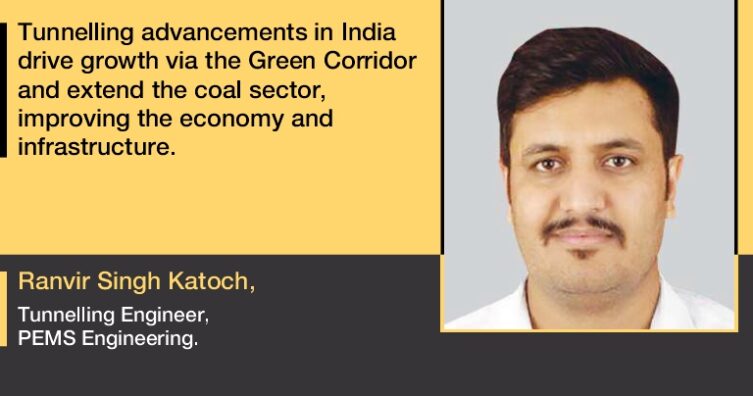India’s coal prominence drives demand for mining and tunnelling equipment, resulting in economic growth, job creation, and Atmanirbhar Bharat. Domestic tunnelling equipment production rises, fostering self-reliance. Green Corridor initiatives promote sustainable mining practises, as emphasised by Ranvir Singh Katoch, Tunnelling Engineer at PEMS Engineering.
How does recent development add value to the mining and tunnelling equipment business?
India is now the world’s largest producer and importer of coal. As committed by the government of India to further increase coal production in India and reduce imports, or even eliminate them, high-tech and modernised machinery, along with a skilled workforce, are required for the proper execution of the work plan. By incorporating these advancements, we can expect a boost to the economy, job creation, the emergence of new entrepreneurs, and also benefit from the Atmanirbhar Bharat Scheme launched by the GOI.
Underground construction demands heavy machinery, and most equipment is manufactured outside India. To expedite the progress of the work, manufacturing plants and units need to be established in India. Advanced probing and tunnel seismic prediction equipment and machines are necessary for the smooth, efficient, and time-bound completion of the work.
How is our mining and tunnelling equipment industry adapting to the present infrastructure scenario?
In recent years, there has been a significant upsurge in India’s domestic production of various small tunnelling equipment and materials, thanks to collaborative efforts with select foreign companies. This strategic partnership has contributed to bolstering India’s self-reliance in the tunnelling sector and has facilitated access to advanced technology and expertise for enhancing the overall quality and efficiency of tunnelling projects in the country.
With the massive expansion plans of roads and highways, which sustainable practices are in place to perform safe and sustainable mining and tunnelling?
India is actively working on expanding and constructing the Green Corridor Highways to promote a sustainable environment. While there are environmental impacts during construction, the government and executing agencies take measures to safeguard resources and follow a well-structured approach. Additionally, they conduct regular plantation drives, including plant relocation from the alignment and plantations in the dumping area, to mitigate environmental effects.
What are the major geological challenges faced during the commencement and completion of mining for underground tunnelling?
While executing the tunnelling work in India, major challenges depend on the work region. In the Himalayan region, the major challenge is tackling the heavy water ingress. To tackle such types of challenges, advanced prediction equipment and sensors are required.
What challenges do contractors and project managers face in acquiring standardised, high-efficiency equipment while ensuring sustainability?
As discussed earlier, most tunnelling equipment is being imported. A skilled and familiar workforce is required for smooth function and precise working by this equipment, which again is difficult to manage in India. Technology sharing is a basic need for accurate knowledge acquisition and the appropriate functioning of any machine or equipment.
How are government regulations and policies fostering the development of Indian infrastructure?
The government is committed to furthering our country’s development and taking all possible measures to bring it into existence. These efforts are aimed at normalising the policies to attract foreign investments in India. They align with the government’s “Manufacture in India, Export for the World” policy. Furthermore, the government is also taking the required steps for early clearance of the project by setting out minimum requirements before handing over any specific site to the executing agencies. Earlier, the primary reason for the delay in projects was delayed land acquisition and the project handover process by the client to the executing agency. But today, such issues have been reduced and are being resolved quite easily to a great extent.
Cookie Consent
We use cookies to personalize your experience. By continuing to visit this website you agree to our Terms & Conditions, Privacy Policy and Cookie Policy.

















